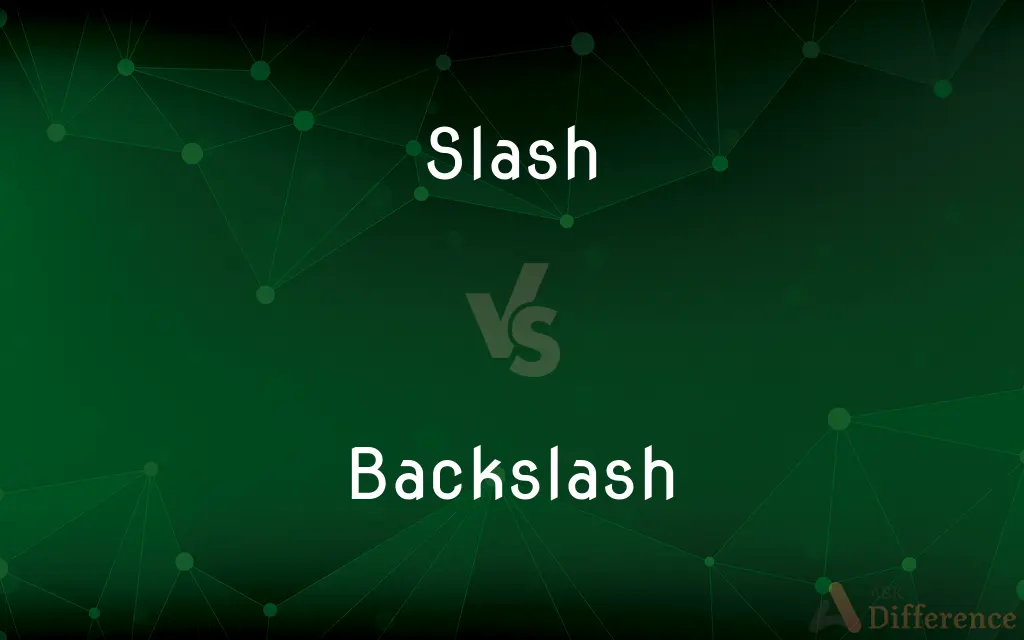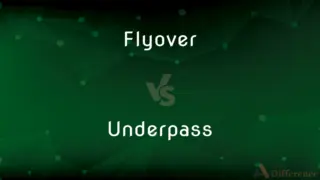Slash vs. Backslash — What's the Difference?
By Urooj Arif & Maham Liaqat — Updated on March 21, 2024
Slash (/) is used to denote division, dates, and paths in URLs, while backslash (\) is primarily used in Windows file paths and escape sequences in programming.

Difference Between Slash and Backslash
Table of Contents
ADVERTISEMENT
Key Differences
The slash, also known as the forward slash, is a punctuation mark used for various purposes, including separating parts of a date (e.g., 03/23/2024), dividing numbers (e.g., 4/2), and denoting paths in URLs (e.g., https://www.example.com). It is also used in computing as a directory separator in UNIX and Linux systems. The backslash, on the other hand, is used as a directory separator in Microsoft Windows file paths (e.g., C:\Program Files\Example). In programming languages like C, C++, and Python, the backslash serves as the beginning of an escape sequence (e.g., "\n" for a newline character), allowing for the insertion of special characters in strings.
While the slash is more universally used in writing, mathematics, and computing (outside of Windows environments), the backslash's use is more specialized, primarily in Windows file systems and coding. The orientation of the slash is upward to the right (/), whereas the backslash tilts upward to the left (\).
In digital communication, slashes are also used to denote alternatives or options (e.g., "and/or"), and in informal writing, it can separate thoughts or indicate a choice. The backslash does not share these uses and is seldom seen outside its technical applications.
The distinction between slash and backslash is crucial in computing environments where path syntax is rigidly defined, such as in scripting and programming, where using one in place of the other can lead to errors or misinterpretations.
Comparison Chart
Primary Use
Division, dates, URLs, paths in UNIX/Linux.
Windows file paths, escape sequences in programming.
ADVERTISEMENT
Orientation
Upward to the right.
Upward to the left.
Computing Use
Directory separator in UNIX/Linux, web URLs.
Directory separator in Windows, escape character in strings.
Writing Use
Denote alternatives, separate parts of a date.
Rarely used in general writing.
Programming Use
Less common; sometimes used in comments.
Escape sequences, file paths in Windows environments.
Compare with Definitions
Slash
Indicates alternatives or options.
Please respond yes/no/maybe.
Backslash
Begins escape sequences in programming languages.
Print a newline using \n.
Slash
A punctuation mark used for division.
The ratio of students to teachers is 20/1.
Backslash
Separates namespaces in some programming languages.
Python uses . instead of \ for namespaces.
Slash
Denotes paths in URLs and UNIX/Linux file systems.
Visit https://example.com/about/
Backslash
Rarely used in everyday writing, mainly technical.
Use \t for a tab character in strings.
Slash
Serves as a linguistic tool in informal writing.
He's an actor/writer.
Backslash
Used in Windows file paths.
C:\Users\Username\Documents
Slash
Separates day, month, and year in dates.
Her birthday is 12/31/2024.
Backslash
Not common in mathematical notation, except in specific contexts.
Set difference can be denoted as A \ B.
Slash
To cut or form by cutting with forceful sweeping strokes
Slash a path through the underbrush.
Backslash
The backslash \ is a typographical mark used mainly in computing and is the mirror image of the common slash /. It is sometimes called a hack, whack, escape (from C/UNIX), reverse slash, slosh, downwhack, backslant, backwhack, bash, reverse slant, and reversed virgule.
Slash
To make a gash or gashes in.
Backslash
A backward virgule ( \ ).
Slash
To cut a slit or slits in, especially so as to reveal an underlying color
Slash a sleeve.
Backslash
The punctuation mark \.
Slash
(Sports) To swing a stick at (an opponent) in ice hockey or lacrosse, in violation of the rules.
Backslash
Used erroneously in reference to, or in reading out, the ordinary slash, that is, the punctuation mark /.
Slash
To criticize sharply
The reviewers slashed the composer's work.
Backslash
To escape (a metacharacter) by prepending a backslash that serves as an escape character, thereby forming an escape sequence.
Slash
(Sports) To hit or propel (a ball, for instance) forcefully in a straight line.
Slash
To reduce or curtail drastically
Slash prices for a clearance sale.
Slash
To make forceful sweeping strokes with a sharp instrument.
Slash
To cut one's way with such strokes
We slashed through the dense jungle.
Slash
To make drastic reductions in something
Slashing away at the budget.
Slash
A forceful sweeping stroke that is made with a sharp instrument.
Slash
A long cut or other opening made by such a stroke; a gash or slit.
Slash
A decorative slit in a fabric or garment.
Slash
A diagonal mark ( / ) that is used especially to separate alternatives, as in and/or, to represent the word per, as in miles/hour, to separate component parts of a URL, as in whitehouse.gov/kids/patriotism/, and to indicate the ends of verse lines printed continuously, as in Old King Cole / Was a merry old soul. Also called virgule.
Slash
Branches and other residue left on a forest floor after the cutting of timber.
Slash
Often slashes Wet or swampy ground overgrown with bushes and trees.
Slash
As well as; and. Used as a representation of the virgule (as in restaurant/art gallery or actor/director), often styled with hyphens in print
A restaurant slash art gallery.
An actor-slash-director.
Slash
A slashing action or motion, particularly:
Slash
A swift, broad, cutting stroke made by an edged weapon or whip.
A slash of his blade just missed my ear.
Slash
(cricket) A wild swinging strike of the bat.
Slash
A hard swift lateral strike with a hockey or lacrosse stick, usually across another player's arms or legs.
Slash
Any similar wide striking motion.
He took a wild slash at the ball but the captain saved the team's skin by hacking it clear and setting up the team for a strike on the goal.
Slash
(figuratively) A sharp reduction.
After the war ended, the army saw a 50% slash in their operating budget.
Slash
A mark made by a slashing motion, particularly:
Slash
A cut or laceration, often deep, made by an edged weapon or whip.
He was bleeding from a slash across his cheek.
Slash
(botany) A deep taper-pointed incision in a plant.
Slash
Something resembling such a mark, particularly:
Slash
(fashion) A slit in an outer garment exposing a lining or inner garment, usually of a contrasting color or design; any intentional long vertical cut in a garment. Clearing
Slash
A clearing in a forest, (particularly) those made by logging, fire, or other violent action.
Slash
The slash mark: the punctuation mark ⟨/⟩, sometimes inclusive of any mark produced by a similar slashing movement of the pen, as the backslash ⟨\⟩.
Slash
Female genitalia.
Slash
The loose woody debris remaining from a slash, the trimmings left while preparing felled trees for removal.
Slash generated during logging may constitute a fire hazard.
Slash
(fandom slang) Slash fiction.
Slash
A drink of something; a draft.
Slash
A piss: an act of urination.
Where's the gents? I need to take a slash.
Slash
(US) A swampy area; a swamp.
Slash
(Scotland) A large quantity of watery food such as broth.
Slash
(UK) slatch: a deep trough of finely-fractured culm or a circular or elliptical pocket of coal.
Slash
To cut or attempt to cut, particularly:
Slash
To cut with a swift broad stroke of an edged weapon.
They slashed at him with their swords, but only managed to nick one of his fingers.
She hacked and slashed her way across the jungle.
Slash
To produce a similar wound with a savage strike of a whip.
Slash
(ice hockey) To strike swiftly and laterally with a hockey stick, usually across another player's arms or legs.
Slash
(figuratively) To reduce sharply.
Competition forced them to slash prices.
Profits are only up right now because they slashed overhead, but employee morale and product quality have collapsed too.
Slash
(fashion) To create slashes in a garment.
Slash
(figuratively) To criticize cuttingly.
Slash
To strike violently and randomly, particularly:
Slash
(cricket) To swing wildly at the ball.
Slash
To move quickly and violently.
Slash
To crack a whip with a slashing motion.
Slash
To clear land, with violent action such as logging or brushfires or through grazing.
The province's traditional slash-and-burn agriculture was only sustainable with a much smaller population.
Slash
To write slash fiction.
Slash
To piss, to urinate.
Slash
To work in wet conditions.
Slash
Used to note the sound or action of a slash.
Slash
(North America) Used to connect two or more identities in a list.
Slash
(North America) Used to list alternatives.
Alternatives can be marked by the slash/stroke/solidus punctuation mark, a tall, right-slanting oblique line.
Slash
To cut by striking violently and at random; to cut in long slits.
Slash
To lash; to ply the whip to.
Slash
To crack or snap, as a whip.
Slash
To strike violently and at random, esp. with an edged instrument; to lay about one indiscriminately with blows; to cut hastily and carelessly.
Hewing and slashing at their idle shades.
Slash
A long cut; a cut made at random.
Slash
A large slit in the material of any garment, made to show the lining through the openings.
Slash
Swampy or wet lands overgrown with bushes.
Slash
A opening or gap in a forest made by wind, fire, or other destructive agency.
We passed over the shoulder of a ridge and around the edge of a fire slash, and then we had the mountain fairly before us.
Slash
A wound made by cutting;
He put a bandage over the cut
Slash
An open tract of land in a forest that is strewn with debris from logging (or fire or wind)
Slash
A punctuation mark (/) used to separate related items of information
Slash
A strong sweeping cut made with a sharp instrument
Slash
Cut with sweeping strokes; as with an ax or machete
Slash
Beat severely with a whip or rod;
The teacher often flogged the students
The children were severely trounced
Slash
Cut open;
She slashed her wrists
Slash
Cut drastically;
Prices were slashed
Slash
Move or stir about violently;
The feverish patient thrashed around in his bed
Common Curiosities
Can I use slashes interchangeably in file paths?
No, the correct symbol must be used according to the operating system: slashes for UNIX/Linux and web URLs, backslashes for Windows.
Why is the slash also called the forward slash?
It's called the forward slash to distinguish it from the backslash, especially in computing contexts where both are used.
Is there a technical reason for the different uses of slash and backslash?
The distinction largely stems from historical and platform-specific conventions rather than technical necessities.
How do I use a backslash in a URL?
Backslashes are not used in URLs; slashes are the correct symbol for separating path segments in a URL.
Why do some programming languages use backslashes for namespaces?
This is a convention specific to certain languages, like PHP, to separate namespace components, not related to file paths.
Why do Windows paths use backslashes?
Windows adopted the backslash as a directory separator early in its development, differentiating it from UNIX/Linux systems.
Do slashes have a role in network addressing?
Yes, slashes are used in network addressing to denote subnet masks or CIDR notation.
What does a double backslash (\\) mean in programming?
A double backslash is used to represent a literal backslash character in strings, as the backslash is an escape character in many languages.
How do I type a backslash on a keyboard without a backslash key?
This depends on the keyboard layout and operating system, but often involves using alternate key combinations or virtual keyboards.
Are there any common mistakes to avoid when using slashes and backslashes?
Yes, mixing up their usage in file paths, URLs, and programming contexts can lead to errors, so it's important to use them correctly according to the context.
What happens if I use a backslash instead of a slash in web development?
Using a backslash instead of a slash in URLs or UNIX/Linux file paths can lead to errors or incorrect resource referencing.
Can using the wrong slash/backslash lead to security issues?
Incorrectly using slashes or backslashes could potentially lead to file path manipulation vulnerabilities in poorly designed systems.
Is the use of slashes in dates universal?
While common, the use of slashes in dates varies by region, with some preferring dots or dashes.
What is the role of slashes in regular expressions?
In many programming languages, slashes are used to delimit regular expression literals.
Can the use of backslashes in escape sequences be customized?
Generally, no. The use of backslashes in escape sequences is a language-specific syntax that cannot be altered by the programmer.
Share Your Discovery

Previous Comparison
Flyover vs. Underpass
Next Comparison
Nerd vs. IntelligentAuthor Spotlight
Written by
Urooj ArifUrooj is a skilled content writer at Ask Difference, known for her exceptional ability to simplify complex topics into engaging and informative content. With a passion for research and a flair for clear, concise writing, she consistently delivers articles that resonate with our diverse audience.
Co-written by
Maham Liaqat















































